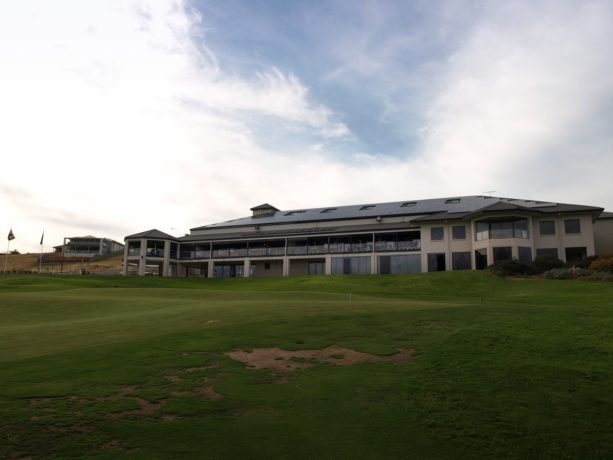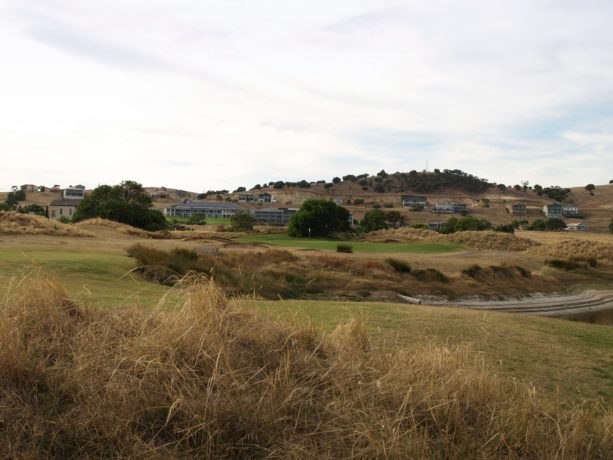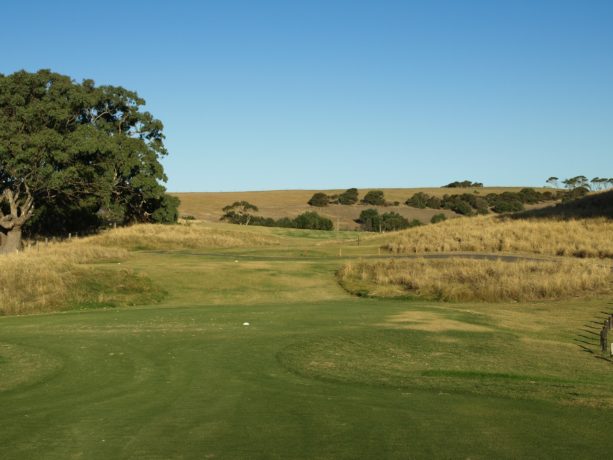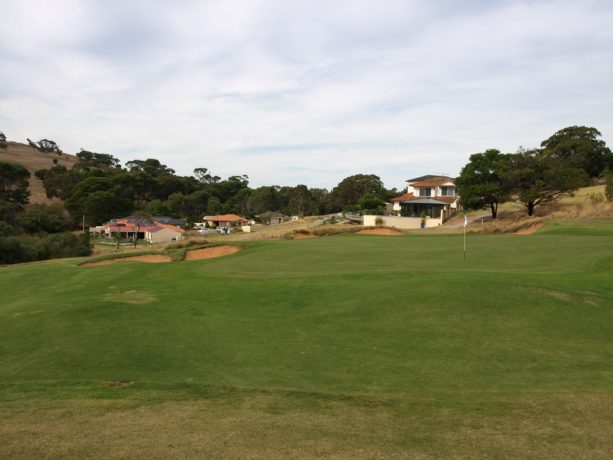
Location: Lady Bay, SA
Established: 2000
Architect: Newton, Grant & Spencer
First Played: 23rd July 2012
Last Played: 1st June 2019
Magazine Ratings

65 (Current)

70 (Current)

31 (Current)
Making my way to Links Lady Bay Golf Resort, the last Top 100 Golf course to play in South Australia. Located just over an hour south of Adelaide on the Fleurieu Peninsula, there are a few other courses in the area also worth visiting.

Links Lady Bay Golf Resort Entrance
The land was originally a sheep and cattle farm, before course construction started in 1998. A housing development has also been established at various points on the course, with plans to sell most of the surrounding area for housing. At the moment this has not progressed as far as expected, which allows for better scenery. In 2004 the hotel complex and clubhouse was established.

Clubhouse at Links Lady Bay Golf Resort
A bar and restaurant are found within the clubhouse, with great views over the 18th hole. A multi story hotel is also attached, with facilities including a day spa being available.

Links Lady Bay Golf Resort Course Map
The course is spread out over quite a big area and designed as a links style course. Originally intended to be a housing estate, there are still many blocks available for sale. Not really a fan of playing through such places, I’m glad that full development is still a few years off. If you get sick of golf, but enjoy wine, it’s well worth making the short trip to McLaren Vale. I came across a brilliant winery, Samuel’s Gorge.

Scorecard for Links Lady Bay Golf Resort
During my visit, a mixture of the blue and white tees were played.

Hole 1 – 334 meter par 4
Starting the round is the easiest index par 4 at Links Lady Bay Golf Resort. This shorter hole plays with a dogleg to the right. A small ridge helps to deceive how much fairway is available. Main danger from the tee is hitting out of bounds down the left side of the hole.

Looking down at the 1st green
A bunker is located front left of the green, but slightly away. Another two are right and rear, near the greens edge. Playing to the centre or right side of the fairway allows a better angle into the green. Thick fescue is found on the surrounding dunes, close enough for any inaccurate shot to have issue. Nice opening hole, not too testing but gives you an idea of what is ahead.

Hole 2 – 351 meter par 4
Another medium length par 4, which turns to the left at a much sharper angle than the previous hole. A lot of space is available for those taking the safer route.

Corner of the 2nd fairway
Those trying to shorten the hole bring danger into play from the waste area to the left, where large areas of fescue await. Staying close to the inner corner will allow an easier angle to the green. Would be good to see this renovated containing more of the sandy base and some of the longer grass removed.

View into the 2nd green
The green sits slightly angled away to the right, with multiple bunkers short on the right, but continuing green side. A small solitary trap also sits on the left side. The putting surface has a few undulations, but sits higher at its rear, than that of the front. Offering a bit of risk reward off the tee, strategy comes into play with positioning for approach. Those just happy to hit the target also have plenty of room.

Hole 3 – 485 meter par 5
Coming to the first long hole of the day, this par 5 has a dogleg to the left. The tee shot is played up a slight hill to an open expanse. Actually not the most exciting shot, even with the hills framing the background. The second is a lot tougher, with the turn coming into play and a narrow fairway to land the ball. A solitary fairway trap sits on the inside of the corner.

Looking back at the 3rd green
Making the approach is best done from the right side of the fairway. A bunker is located over this side, but makes for a better angle and clearer view of the green. Some hollows are found short of this raised green which has three traps on its surrounds. The putting surface is quite long, which angles away to the left of the fairway. It is only from the second shot on that the hole becomes interesting, where some clear strategy is required.

Hole 4 – 321 meter par 4
A short par 4 runs along the base of a hill bordering the course. From a slightly elevated tee, the fairway runs away but also slopes from the left. This brings into play two fairway traps on the lower side.

Hazard before the 4th green
A small hazard is found short of the green, so distance control will be critical with the approach for any front pin positions. An unusual green, in an L shape, could see some interesting putts if finding the wrong portion. For example, finding the front right of the green, with a pin at the back, could mean play over/around a bunker. There are a few slopes on the putting surface which could cause problems also. Not the most strategic of holes, but interesting to play.

Hole 5 – 414 meter par 4
Next is the longest par 4 at Links Lady Bay Golf Resort. From the tee, the fairway runs down a very slight slope. The fairway snakes its way with a hazard to the right.

Bunkering on the 5th fairway
Two traps sit on the left side, which is the side offering the best angle to the whole green. This area sits between the traps and the hazard so a bit of risk verse reward is offered. To run the ball in finding the right side of the fairway is a better option.

Looking towards the 5th green
A large trap is short left of the green, helping to deceive distance. If playing from the left this must be carried. The putting surface has two distinct tiers, with the rear sitting higher. Tough hole when into the wind, luckily not the case on my day of play. Offers strategy from tee to green, but requires some well struck shots.

Hole 6 – 147 meter par 3
One of the more flatter areas of the course, this mid length par 3 requires a carry over fescue to reach the green.

Heavily bunkered 7th green
Shaped like a plus symbol, this green is heavily bunkered on all sides. Finding the right portion is critical. The centre sits higher than most of the sides, leading to some interesting undulations and tough putts.

Hole 7 – 488 meter par 5
Starting the journey along the western boundary, is the easiest index par 5. A wide fairway awaits between some low dunes. Some thought is required on where to land the tee shot.

Lake beside the 7th fairway
Especially due to the lake coming into play on the second shot. If long enough there is the possibility of taking on the risk to carry the water. For mere mortal, when to land the second shot becomes the big question. Short of the water or on the narrowing fairway to the left.

View of the 7th green
The putting surface is quite long and angles away to the left, where a large collection of bunkers and mounds are found. Various hollows are found on the surrounds, but attention must be made to the large ridge through the middle of the green. The hole asks questions with every shot. Designed to reward the risk takers, the hazards are fairly well placed. But allowance for all levels of player are taken into consideration making this a fair hole.

Hole 8 – 160 meter par 3
Heading back towards the clubhouse sees consecutive holes running in an easterly direction. To start is this mid length par 3. Water from the previous hole comes into play again, with it encroaching around the halfway point on the hole. There is still ample room on the left for those not quite confident on the carry, but a line of bunkers will be encountered leading into the green.

Bunkers protect the 8th green
The green angles away to the right, favouring right to left shaped shots. Sitting slightly raised on the right portion, this is also the more open section. Not a big fan of this design. A carry of some sort is required to play the hole, so if windy conditions are found, becomes a bit of an issue with little option. Removing some of the forward bunkers would make this more interesting, allowing a variety in play.

Hole 9 – 372 meter par 4
To finish the front loop is a mid-long par 4. The fairway starts out a reasonable width with mounds either side, but starts to narrow quickly. Finding the rough is the main danger for the tee shot. Playing down the right side will shorten the hole slightly, although there is no big advantage with the line on the approach.

Looking back at the 9th hole
At the green complex space open up, especially at the front, but is littered with bunkers, mounding and hollows. A large putting surface is available, which has various undulations to contend with. Just hitting the green does not guarantee a two putt. Accuracy is critical with the tee shot, but some forgiveness given on the second. Some interesting shaping at the green complex will allow a variety of shots to be played.

Hole marker at Links Lady Bay Golf Resort
Each hole had relevant information on a wooden post, which actually blended in well with the course surroundings. The pin flags had the course logo, but unfortunately I had a brain fade and didn’t get a shot of these.

Hole 10 – 330 meter par 4
To start the second loop is a shorter par 4, although playing a bit longer than it suggests. The tee shot will carry a small rise before finding the valley beyond. A large fairway awaits, but those playing too far left will find sand trouble. Two mounds are located on the right section, with semi covered with fescure, just to add a bit more difficulty.

Looking over at the 10th green
With the green angling away to the left, making from the approach from the right of the fairway may add a slight advantage. A small bunker short must be carried, but this allows easier access to the wide rear section of the green. The front portion is narrow but slopes significantly back towards the fairway. A ridge runs through the middle of the green which will be encountered if landing on the wrong section. Enjoyable hole which allows some aggressive play, but anything wild will be punished.

Hole 11 – 359 meter par 4
Climbing the rest of the hill finds the 11th tee. The fairway sits partially hidden down the hill. With a turn to the left, those willing to take the risk can carry the dunes on the left side, leaving a shorter shot. Failing to do so may find the fescue and require a reload. The right side of the fairway is heavily bunkered, so those taking the safer route need to ensure not to carry the ball too far.

View of the 11th green
A large collection of sandtraps are found short and running down the right side. Bordered by fescue at their rear, this isn’t the side to miss. One trap is found left of this large green, which also widens towards the rear. There are quite a few undulations here to contend with on the putting surface, so there are no easy putts. Very enjoyable hole ensuring some thought with each shot.

Hole 12 – 390 meter par 4
Heading back in the opposite direction is the hardest index par 4 at Links Lady Bay Golf Resort. From the tee dunes are found either side and appear to leave a narrow alley. Beyond these the ground falls away but also opens to a wide expanse.

Bunkers short of the 12th green
The approach will be up a decent incline, leaving most of the green blind. A narrow entrance is found between more dunes to the green complex. One large trap is found short left, leaving a very difficult shot, so best avoided.

Looking back at the 12th green
Five smaller bunkers are found around the green, two left, two right and one rear. The putting surface widens towards the rear, but has some dramatic undulations on the left side. Tough hole, especially into the breeze. Difficulty is found mainly in the second section of the hole. There is no critical strategy to follow, although pin position will really determine which side of the fairway to make the approach.

Hole 13 – 276 meter par 4
Some respite is given on the next hole, being the shortest par 4 on the course. A blind tee shot is required on this hole which doglegs to the right. Playing down the inside of the corner may shorten the hole, but brings bunkers into play. Playing slightly inside out, taking on the risk of the boundary fence down the left, will leave a better angle into the green.

Approach from the 13th fairway
The bunkers down the right are surrounded by fescue, leading to either a lost ball or tough shot at the green. This is actually a double green, joining the 16th, via a narrow neck. A couple of small undulations are found on this narrow putting surface. Knowing the pin position is important, especially to work out the best angle for the approach. A hole best played twice.

Hole 14 – 328 meter par 4
Another shorter par 4 follows, which runs along the eastern boundary, playing with a slight turn to the right. From the tee two water hazards need to be carried before reaching the fairway.

Approach angle before the water on the 14th fairway
Longer hitters wanting to avoid the left fairway bunker, need to be cautious of the third water hazard found to the right. For some laying up short of this will leave a difficult approach, with a tree blocking access to the green. The ideal line is along the left fairway bunker, giving a better angle into the green.

Another hazard short of the 14th green
If three hazards were not enough, be ready to deal with a fourth just short of the green. The putting surface is quite large and slightly raised. This has allowed some deep bunkers and various hollows to be placed on the surrounds. Certainly a stark contrast to the other holes on the course, mainly due to the amount of water in play the whole length. Strategy wise this gets a little convoluted. The tree blocking the line from the right doesn’t do the hole any favours. Carrying the water is sufficient as a hazard. Blocking it in the air also is not required.

Hole 15 – 126 meter par 4
Keeping with the theme of short holes, is the shortest and easiest index hole on the course. Playing up a decent hill, the base of the pin will be unseen. The left side is heavily littered with sand traps. A couple short then four more starting centre left, running along to the back.

Looking across at the 15th green
The green slopes significantly from the rear back towards the tee and has some distinct quadrants. Finding yourself above the pin will leave a difficult shot or putt. Testing short hole where distance control is critical. Allowing for a variety of shots and player ability.

Hole 16 – 495 meter par 5
Starting the journey back to the clubhouse is the longest par 5. From an elevated tee the fairway falls away before reaching a turn to the left. This also slopes left to right, making the bunkers an ideal target, letting the ball run away down the slope.

Approach from the 16th fairway
A tough decision is required for the second shot. If close enough to attempt to reach the green, or layup short. For those deciding to layup, a cross bunker must be negotiated, whilst a row of bunkers run the left side beyond this. Playing close to this area will leave a better angle into the green. The putting surface slopes from the left with some small undulations. This joins the back of the 13th green. Nice hole requiring the player to think with each shot. This is especially the case from the second shot on.

Hole 17 – 167 meter par 3
The penultimate hole is the longest and hardest index par 3. A long carry over fescue is required before find the short grass. Being at one of the higher points to the course, strong winds of the shore can be encountered. Smart design has been incorporated by leaving the green entrance open, with around 50 meters of short grass for the ball to run in.

View down to the 17th green
Boarded by some smaller dunes, eight bunkers are found on the surrounds of the green. The putting surface has some large undulation to the right and varying slopes to contend with. The green is fairly long, which is well suited to the length of the hole. Considered the signature hole on the course, it’s not just the look that ensure this. The design is one of the best on the course.

Hole 18 – 477 meter par 5
To finish the round is the shortest, yet hardest index par 5. Playing from an elevated position, the tee shot must carry some native grass before reaching the fairway below. Bunkers are found centre and to the right of the fairway, which gently slopes in this direction. The landing area is very generous, but if a little wild, will find long grass.

Approach from the 18th fairway
The second shot sees the fairway narrow at times, with various bunker complexes along the right side.

Humps and hollows around the 18th green
If laying up, it is better to note where the pin is located, before deciding which side to land the ball. On the surrounds, many bunkers, humps and hollows. The putting surface is almost in the shape of an L, although not as harsh as the 4th hole. This is a strong finishing hole which will test the player, but also reward for smart play.
Looking at the course makeup:
- Hole Directions – There was a good variety allowing for conditions to have wide ranging effects during play. Direction was fairly evenly spread throughout the compass, although a slightly higher percentage faced south west. A majority of the time each hole would head in a different direction, although the 6th & 7th both went in a similar direction
- Hole Lengths – Par three holes had a decent variance in distance, the majority in mid length. Par four holes ranged from short to long with an equal split of each. Par 5 holes were all long in distance, not offering much variety. Both nines were well balanced in the amount of par types between each, but also in regards to hole distance
- Hole Layout – There was a some mixture in how the holes played, although an overwhelming majority tended to favour turns to the left, where two shots or more were required to reach the green. This outnumbered those turning to the right almost two to one
Conditions overall for the course were very consistent and probably the best for any course in the area. Tees were very level, having a good rotation so you were not hitting out of divots. Fairways were excellent, with consistent grass coverage. Colouring was a bit odd due to the water quality, causing a dead patch look, although this was far from the case. Bunkers had a fairly consistent coverage in sand and a more rugged look with tufts of grass on the edges. Green complexes were generally good, with short grass on most surrounds being short. There were instances of bare spots though on some holes.
There were a few standout holes on the course for me, they being 2, 4, 5, 10, 11, 13, 17 and 18. Overall a memorable experience for scenery and more importantly a well balanced, design course.
In summary this was a course worth visiting. Overall it did have a good links feel, although this changed on holes 14-16, with 14 feeling very out of place. Some interesting holes which asked questions of the player from tee to green, although there were a few which seemed devoid of any strategy or it was only on the second section.
So my big question is whether I would return or not. The answer is yes. Could quite easily fit in a visit every few years without question. If I was a local to Adelaide, would not hesitate to head down for the day or even stay for the weekend. There is enough variety in the design, which caters for all level of player, to encourage a return visit.
How to play at The Links Lady Bay Link:
1. This is a publicly accessible course. Contact the pro shop to organise a tee time

